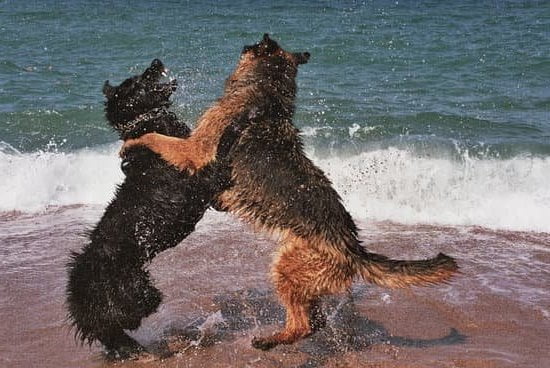Dog training is an essential aspect of owning a dog. It not only shapes their behavior but also establishes a strong bond between the owner and their furry companion. Formal dog training, in particular, is considered the most effective way to train dogs and ensure their overall obedience. In this article, we will explore what is considered formal dog training, its significance in shaping a dog’s behavior, and the many benefits it brings.
Formal dog training can be defined as structured and professional training that focuses on teaching dogs specific commands and behaviors through consistent practice and reinforcement. Unlike informal training methods, which may rely on instinct or trial and error, formal training utilizes proven techniques to teach dogs proper obedience skills. This type of training provides clear guidance for both the owner and the dog, establishing a foundation of communication and understanding that leads to improved behavior.
The impact of formal dog training goes beyond simply having an obedient pet. It can transform unruly or difficult dogs into well-behaved companions. With formal training, owners can effectively address behavioral issues such as jumping, barking excessively, pulling on the leash, or not coming when called. Through structured lessons and repetition, dogs learn essential commands like sit, stay, come, and other behaviors that promote good manners and safety.
In the following sections of this article, we will delve deeper into understanding formal dog training by exploring its core components and highlighting its numerous benefits. Additionally, we will discuss different techniques used by professional trainers and provide practical advice on finding a qualified trainer. Stay tuned for valuable insights on creating a consistent training schedule at home as well as strategies to overcome common challenges in formal dog training.
Understanding Formal Dog Training
Formal dog training is a structured and organized approach to teaching dogs various behaviors and commands. It involves following a specific curriculum or program designed to improve communication between the owner and the dog, enhance socialization skills, and increase obedience levels. Unlike informal training methods, formal dog training is typically conducted by professional trainers or instructors who have extensive knowledge and experience in guiding dogs through a structured learning process.
The main difference between formal and informal dog training lies in the structure and consistency of the training sessions. Informal training methods often revolve around teaching dogs basic commands or behaviors on an ad hoc basis, without following a specific plan or curriculum. These methods may include simple verbal instructions or gestures from the owner without any additional reinforcement techniques.
On the other hand, formal dog training programs are designed to be systematic and progressive, with an emphasis on positive reinforcement techniques. They often include a series of steps or levels that build upon each other, starting with basic commands like sit, stay, and come before progressing to more advanced behaviors. Formal dog training also incorporates leash training, impulse control exercises, and socialization with other dogs and people.
| Informal Training | Formal Training |
|---|---|
| – Ad hoc basis | – Structured and progressive |
| – No specific curriculum | – Follows a specific program |
| – Simple verbal instructions/gestures | – Mixes verbal cues with positive reinforcement techniques |
Formal dog training provides several benefits for both dogs and their owners. It establishes clear communication channels between the two parties, allowing them to better understand each other’s needs and expectations. This improved communication leads to a stronger bond between the dog and its owner, as well as a greater sense of trust and respect.
In addition, formal training enhances socialization skills in dogs, making them more comfortable and confident in various situations. Dogs learn to interact appropriately with other dogs and people, reducing the likelihood of aggressive or fearful behavior. Furthermore, formal training helps improve obedience levels, ensuring that dogs respond promptly and reliably to commands regardless of distractions or environmental factors.
Overall, understanding the concept and importance of formal dog training is crucial for anyone looking to train their dogs effectively. By following a structured program and employing positive reinforcement techniques, owners can establish a strong foundation of behaviors and commands that will benefit their furry companions throughout their lives.
The Benefits of Formal Dog Training
Formal dog training offers a wide range of benefits for both dogs and their owners. By engaging in a structured and organized training program, individuals can greatly improve their communication with their canine companions, enhance socialization skills, and achieve higher levels of obedience. These advantages make formal dog training an essential component in raising a well-behaved and obedient dog.
One of the key benefits of formal dog training is improved communication between owners and dogs. Through consistent training techniques and commands, dogs learn to understand and respond to their owner’s cues effectively. This clear line of communication helps establish mutual trust and strengthens the bond between the owner and their furry friend. As dogs become more proficient in understanding commands, they are able to follow instructions more reliably, leading to better obedience overall.
Another advantage of formal dog training is enhanced socialization. During training sessions, dogs have the opportunity to interact with other dogs as well as different people. This exposure helps them develop appropriate social behaviors and responses when encountering new situations or individuals.
The controlled environment of formal training allows trainers to guide dogs through these interactions, teaching them how to behave politely around others. This ultimately leads to a well-socialized dog that can easily adapt to various environments without displaying anxiety or aggressive behavior.
Increased obedience levels are also a significant benefit of formal dog training. Through consistent practice and reinforcement during training sessions, dogs learn basic obedience commands such as “sit,” “stay,” “come,” and more complex tasks like leash walking or impulse control. These skills not only make day-to-day life easier for both owners and their pets but also contribute to the overall safety of the dog in various situations.
In summary, formal dog training provides numerous benefits that positively impact both dogs and their owners. Improved communication leads to stronger relationships between owners and their pets, enhanced socialization skills help dogs navigate different environments confidently, while increased obedience levels result in better behavior overall. Engaging in a formal training program allows dogs to reach their full potential and become well-behaved, obedient companions.
| Advantages of Formal Dog Training |
|---|
| Improved Communication |
| Enhanced Socialization |
| Increased Obedience Levels |
Key Components of Formal Dog Training
Key Components of Formal Dog Training: Exploring the core elements that are typically included in a formal dog training program, such as basic obedience commands (sit, stay, come), leash training, and impulse control.
Formal dog training programs often incorporate several key components to ensure comprehensive training and promote well-rounded obedience in dogs. These components focus on teaching essential skills and behaviors that are fundamental to a dog’s overall development. The core elements typically included in formal dog training programs encompass basic obedience commands, leash training, and impulse control.
Basic obedience commands play a crucial role in formal dog training as they provide the foundation for effective communication between the owner and the dog. Commands such as sit, stay, and come are essential for controlling a dog’s behavior and ensuring their safety in different situations. Through consistent practice during formal training sessions, dogs learn to respond promptly to these commands, making it easier for owners to manage their dogs both at home and in public settings.
Leash training is another vital component of formal dog training. Teaching a dog to walk calmly on a leash not only enhances their safety during walks but also promotes good manners when encountering other people or animals. Proper leash handling techniques taught by trainers help dogs understand how to walk without pulling or lunging, ensuring an enjoyable walking experience for both the owner and the dog.
Impulse control is an important skill that helps dogs make appropriate choices when faced with distractions or temptations. In formal training programs, dogs are taught how to resist impulses like chasing after squirrels or jumping on guests. This skill is particularly significant for preventing unwanted behavior such as aggression or destructive chewing. By instilling impulse control through specific exercises and techniques prescribed by professional trainers, owners can help their dogs develop self-control and make better decisions in various situations.
Overall, these core components of formal dog training work together to create a solid foundation of obedience in dogs. By focusing on basic obedience commands, leash training, and impulse control, formal training programs ensure that dogs develop essential skills and behaviors that are pivotal for their overall well-being and the harmony of their relationship with their owners.
Through consistent practice and reinforcement, owners can observe remarkable improvements in their dogs’ behavior and enjoy the benefits of a well-trained canine companion.
Training Techniques Used in Formal Dog Training
Formal dog training utilizes a variety of techniques to teach dogs proper behavior and obedience. These techniques are implemented by professional trainers to ensure effective results. Some common training techniques used in formal dog training include positive reinforcement, clicker training, and marker training.
Positive Reinforcement
This technique focuses on rewarding desired behaviors and ignoring or redirecting unwanted behaviors. Positive reinforcement can be in the form of treats, praise, or playtime. By associating good behavior with positive rewards, dogs are encouraged to repeat those behaviors in order to receive more rewards. This method helps build a strong bond between the owner and dog based on trust and cooperation.
Clicker Training
Clicker training involves using a small device that makes a distinct clicking sound when pressed. The click serves as a signal for the dog to understand that they have performed the desired behavior correctly. It is then followed by an immediate reward such as a treat or praise. The clicker acts as a clear and consistent form of communication between the owner and dog, allowing for precise timing and feedback during training sessions.
Marker Training
Marker training is similar to clicker training but utilizes verbal markers instead of a device. This technique relies on using specific words or phrases such as “good” or “yes” to indicate that the dog has done something correctly. The marker is followed by an immediate reward, reinforcing the desired behavior. Marker training helps create clear associations between verbal cues and actions, facilitating better communication between the owner and dog.
Each of these techniques emphasizes positive reinforcement rather than punishment or harsh methods. They focus on teaching dogs through motivation, encouragement, and understanding rather than fear or intimidation. It is important for owners to understand these techniques before practicing them with their dogs, as consistency is key for successful formal dog training utilizing any of these techniques.
Finding a Qualified Formal Dog Trainer
Finding a Qualified Formal Dog Trainer
When it comes to formal dog training, finding a qualified and experienced dog trainer is essential for achieving optimal results. A reputable trainer with expertise in formal training methods can help guide both the owner and the dog through the process effectively. Here are some tips and guidance on how to choose a qualified formal dog trainer.
Research Different Training Methods
Before selecting a formal dog trainer, it is important to educate yourself about different training methods. You should have a clear understanding of what formal training entails and the specific techniques used by trainers. Familiarize yourself with concepts such as positive reinforcement, clicker training, marker training, and other techniques commonly used in formal dog training. This knowledge will help you make an informed decision when choosing a trainer who aligns with your preferred approach.
Ask for Recommendations
One of the best ways to find a qualified formal dog trainer is by seeking recommendations from trusted sources. Ask friends, family members, or your local veterinarian if they know any reputable trainers in your area. Additionally, consider joining online forums or social media groups dedicated to pet owners, where you can ask for recommendations from fellow dog owners who have undergone professional training with their dogs.
Check Qualifications and Experience
When considering potential trainers, always check their qualifications and experience. Look for certifications or credentials from recognized professional organizations such as the Certification Council for Professional Dog Trainers (CCPDT). These credentials indicate that the trainer has met certain standards of knowledge and expertise in dog training. Furthermore, inquire about their experience working with dogs similar to yours in terms of breed, age, or behavioral issues.
Observe Classes or Sessions
Take advantage of opportunities to observe potential trainers in action before making a final decision. Many trainers offer prospective clients the chance to sit in on group classes or private sessions to get a feel for their training style and methods. This firsthand experience will allow you to assess the trainer’s ability to communicate with dogs effectively, as well as their overall professionalism and rapport with clients.
Ask Questions
During your initial consultations or when observing sessions, don’t hesitate to ask questions to evaluate the potential trainer further. Inquire about their training philosophy, preferred techniques, and approach to handling behavioral issues. Additionally, ask how they tailor their training programs to individual dogs and whether they provide any ongoing support or resources after the formal training is completed.
Remember that finding a qualified formal dog trainer requires some time and effort. While cost is an important consideration, prioritize the quality of the trainer’s expertise and reputation rather than simply choosing based on price alone. By selecting a reputable professional who specializes in formal training methods, you can ensure that your dog receives proper guidance and achieves long-lasting obedience and behavior improvements.
Creating a Training Schedule
Consistency and structure are crucial elements in formal dog training. Having a well-established training schedule not only helps your dog learn faster, but it also provides them with a sense of stability and predictability, which can reduce anxiety and promote better overall behavior. Here are some suggestions on how to create an effective training schedule for your dog at home:
- Set Aside Dedicated Training Time: It is essential to allocate specific times during the day solely for training sessions. Consistency in timing will help your dog understand when it is time to focus and engage in learning.
- Start with Short Sessions: Dogs have short attention spans, especially when they are new to training. Begin with short, frequent sessions of about 10-15 minutes each. As your dog progresses, you can gradually increase the duration of the sessions.
- Be Mindful of Your Dog’s Energy Levels: Plan your training sessions when your dog is more likely to be attentive and responsive. Avoid training immediately after meals or when they are excessively tired or excited.
- Include Regular Reinforcement Sessions: Apart from dedicated training time, incorporate reinforcement sessions throughout the day to reinforce learned behaviors and commands. These mini-sessions can be as simple as asking your dog to sit before giving them food or throwing a ball for them to fetch.
- Use Positive Reinforcement: Always reward your dog with praise, treats, or toys for their correct responses during training. Positive reinforcement helps reinforce good behavior and motivates your furry friend to continue learning.
Remember that every dog is unique, so monitor their progress closely and adapt the training schedule accordingly. Stay patient, consistent, and persistent while sticking to the established routine, as this will greatly aid in successful formal dog training.
Key Points
- Consistency and structure are essential in formal dog training.
- Dedicate specific times for training sessions to establish routine and predictability.
- Start with short sessions and gradually increase the duration as your dog progresses.
- Plan training when your dog is more likely to be attentive and responsive.
- Regular reinforcement sessions throughout the day help reinforce learned behaviors.
- Use positive reinforcement to reward your dog for correct responses.
Common Challenges and Solutions in Formal Dog Training
Formal dog training can be a highly effective way to improve your dog’s behavior and obedience. However, just like any other type of training, it is not without its challenges. In this section, we will address some common obstacles that owners may face during formal dog training and provide practical solutions and strategies to help overcome them.
- Lack of Motivation: One common challenge that owners may encounter is a lack of motivation from their dogs. This can make it difficult to keep them engaged and focused during training sessions. To overcome this challenge, it is important to find what motivates your dog the most.
This could be treats, praise, toys, or even playtime with you. By using positive reinforcement techniques and finding the right motivator for your dog, you can keep them interested and eager to participate in the training process. - Distractions: Another common challenge in formal dog training is dealing with distractions. Dogs are naturally curious animals and may get easily distracted by their surroundings. This can make it challenging to maintain their focus on the training exercises.
To address this issue, start training in a quiet location with minimal distractions and gradually increase the level of distraction as your dog progresses. Use verbal cues or hand signals to regain their attention when they become distracted and reward them for refocusing on you. - Fear or Anxiety: Some dogs may exhibit fear or anxiety during formal training sessions, which can hinder their ability to learn new commands or behaviors. It is important to create a calm and stress-free environment for your dog during training sessions.
Take things slow and gradually introduce new commands while using positive reinforcement techniques to build their confidence. If your dog continues to show signs of fear or anxiety, it may be helpful to consult with a professional trainer who can provide guidance on how to address these issues effectively.
Maintaining Formal Training Results
Once a dog has completed formal training, it is important for owners to understand that maintaining the learned behaviors and skills requires ongoing training and reinforcement. Consistency is key in ensuring that the dog retains what they have learned and continues to exhibit good behavior over time. By consistently practicing the trained commands and incorporating them into the dog’s daily routine, owners can solidify the results of formal training.
One of the long-term benefits of ongoing training is that it helps to strengthen the bond between owner and dog. By consistently engaging with their dogs through training exercises, owners are able to maintain clear communication channels, which not only fosters a stronger relationship but also reinforces trust and respect. These positive interactions provide mental stimulation for the dog, keeping their mind active and preventing boredom or destructive behavior.
In order to continue maintaining formal training results, it is essential for owners to incorporate regular practice sessions into their daily routine. This can be done by setting aside dedicated time each day for obedience drills or engaging in short training sessions throughout various activities. For example, during walks or playtime, owners can continue reinforcing basic obedience commands such as sit, stay, or come. By integrating these commands into different contexts, dogs learn to respond reliably regardless of distractions.
Furthermore, regularly introducing new challenges and gradually increasing difficulty during practice sessions can help prevent regression in behavior. Dogs thrive when they are mentally stimulated and challenged. Owners can explore advanced training exercises or even enroll their dogs in more specialized courses such as agility or obedience trials. This type of continued education not only maintains learned behaviors but also provides an opportunity for further growth and development.
Conclusion
In conclusion, formal dog training plays a crucial role in shaping a dog’s behavior and overall obedience. By participating in formal training programs, owners can witness a remarkable transformation in their dogs, turning them into well-behaved and obedient companions. This article has highlighted the importance of formal training and its distinction from informal methods.
One of the key benefits of formal dog training is improved communication between owner and dog. Through structured training sessions, dogs learn to understand and respond to commands more effectively, creating a stronger bond between them and their owners. Additionally, formal training enhances socialization skills, enabling dogs to interact positively with other animals and people.
Consistency is essential in formal dog training. Following a proper schedule and sticking to it helps dogs understand expectations and reinforces learning. Patience is also crucial during the training process as dogs may require time to grasp new commands or concepts. Positive reinforcement techniques such as praise and rewards play a vital role in motivating dogs to continue learning.
It is important for owners to find a qualified dog trainer who specializes in formal training methods to ensure effective results. Choosing the right trainer will help create a positive learning environment that maximizes success. Furthermore, maintaining the learned behaviors requires ongoing reinforcement even after the formal training program concludes.
Frequently Asked Questions
What are the three styles of dog training?
The three styles of dog training are positive reinforcement, classical conditioning, and aversive training. Positive reinforcement focuses on rewarding desired behaviors with treats, praise, or play to encourage those behaviors to be repeated. This style emphasizes the use of rewards rather than punishments to train the dog.
Classical conditioning involves associating a neutral stimulus with a positive or negative event to elicit a certain response from the dog. Aversive training, on the other hand, involves using punishment or negative reinforcement such as verbal reprimands or physical corrections to discourage unwanted behaviors and promote obedience.
What is the best age to start formal dog training?
The best age to start formal dog training varies depending on the breed and individual development of the dog. Generally, it is recommended to start formal training when the puppy is around 8-12 weeks old, as they are more receptive to learning during this period.
Puppies have a short attention span but can still benefit from basic commands like sit, stay, and come if taught in short sessions using positive reinforcement methods. It’s crucial to keep in mind that early socialization is equally important during this stage of their growth.
What is the difference between modern and traditional dog training?
Modern dog training approaches differ from traditional ones primarily regarding their emphasis on positive reinforcement rather than punishment-based techniques. Traditional dog training methods often relied on correction-based measures such as leash jerking, collar correction, or other types of aversive tools to suppress unwanted behaviors by inflicting discomfort or pain on the dog.
Modern dog training focuses on building trust through reward-based techniques like treats, toys, clickers, praise, and playtime in order to motivate dogs and reinforce desired behaviors positively. This approach acknowledges that dogs respond better when they associate learning with enjoyable experiences instead of fear or pain inflicted upon them by aversive methods used in traditional training approaches.

Welcome to the blog! I am a professional dog trainer and have been working with dogs for many years. In this blog, I will be discussing various topics related to dog training, including tips, tricks, and advice. I hope you find this information helpful and informative. Thanks for reading!





